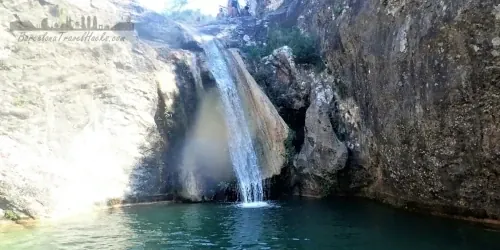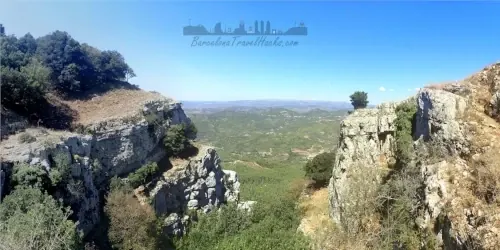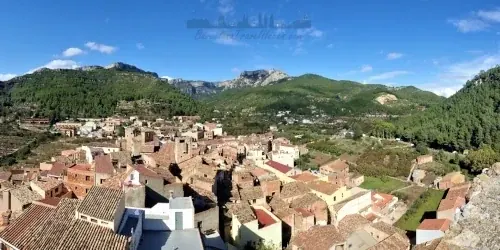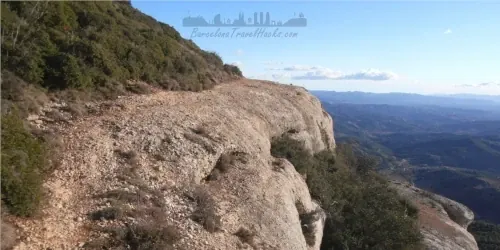
Warning: Undefined array key "HTTP_ACCEPT_LANGUAGE" in /home/barcjkkl/public_html/App/Config/MySQL/language.php on line 32
Deprecated: explode(): Passing null to parameter #2 ($string) of type string is deprecated in /home/barcjkkl/public_html/App/Config/MySQL/language.php on line 36
Llaberia Natural Park, Serra de Montsant & Prades Mountains
A guide of outdoor activities and places to visit in the mountains to the north of Tarragona typified by the dry rocky landscape and fantastic cliffs.
About the Llaberia Natural park
The Llaberia mountain range comprises the Montalt mountain and the Mola de Colldejou and forms part of the Catalan Coastal Mountain Range. It has sheer drops, with huge cliffs and ravines. The chalky nature of its rocks affected by coastal wind and rain erosion has left plenty of caves and chasms.
The laberia range has forests in the mountain and crop growing land on the lower parts. Holm oaks are interspersed with deciduous trees which change to a vibrant colour in autumn. This mountain range is very dry all year round and suffers from a large number of forest fires with the native trees being replaced by Aleppo pines and kermes oaks or thick scrub of rosemary and heather.
Woodpeckers and birds of prey are plentiful here, as are green frogs and salamanders in the few rivers and watercourses. There are also various species of snake and lizard.
The Llaberia Mountain Range is surrounded by small villages that retain all their original charm such as Pratdip and Marca. In the interior of the park there is a small hamlet called Llaberia that is only inhabited in the summer. Along the paths in this natural park you can find Iberian settlements, isolated farmhouses and numerous dry-stone constructions, such as riverside walls, pens and lime kilns. You can explore the mountain range on foot, on mountain bike or on horseback. And the cliffs present a great opportunity for climbing.
The best time of year to admire the views from the Llaberia peeks are from autumn up to the beginning of spring, when the predominant north-westerly wind, the mistral, blows the clouds from the sky.
Serra de Montsant Natural Park
Located in the north of the Priorat region with an area of 9,242 hectares of especially rocky territory in the western most part of the Catalan pre-littoral range. nearby villages are Escaladei, La Morera de Montsant, Ulldemolins, Margalef, Cabaces, Cornudella de Montsant, La Vilella Alta, La Vilella Baixa, La Bisbal de Falset and La Figuera.
The park is most famous for the spectacular rocky walls of the Montsant cliff, on the southern and coastal facing side, which rise to meet the plateau with the highest peaks of Cogulla (1,063 metres), the pilo dels Senyalets (1,109 metres) and the Corbatera rock (1,163 metres).
To the north of Montsant range flows the Montsant river with the majestic Fraguerau gorge, in the district of Ulldemolins. It then opens into the Margalef reservoir before turning towards the south. The Fraguerau gorge is also where the 12th century Sant Bartomeu shrine and hermitage can be found.
Mammals such as greater horseshoe bats, wild cats or Spanish ibex; birds of prey such as Bonelli's eagle, golden eagles, peregrine falcons or kestrels, as well as other birds, reptiles, amphibians, invertebrates or fish inhabit the park. holm oak and shrubs dominate the majority of the landscape with some Aleppo and Scots pine forests, as well as common oak forests.
Prades Natural park
The Prades Mountains are the largest protected natural area in the region with immense biological diversity and distinctive habitats and landscapes. Prades Mountain range sits between the counties of Alt and Baix Camp, Conca de Barbera and Priorat in the tarragona region.
Popular tourist destination towns and villages around the Prades mountains are L'Espluga de Francoli, medieval walled town of Montblanc, Cornudella de Montsant and siurana village and reservoir.
Prades is proposed to become a natural park in 2023.
Click on any of the images below to read more and find the walking route, relevant transport information such as bus or train timetables, restaurants and weather.
Happy Exploring!
4 Attractions in the Llaberia Montsant & Prades Natural Parks


Mola De Colldejou Plateau Hiking Trail in Llaberia Natural Park
18km route in Llaberia natural park via forestall paths. Ravine to Moll de Colldejou plateau ruined castle. Panoramic views of coastline and interior landscape
Read more >

Pratdip circular hiking route in Llaberia Natural Park
Hiking in the hellhound & vampire village of Catalunya. A medium hard 16km circular route in the Llaberia Natural Park
Read more >
